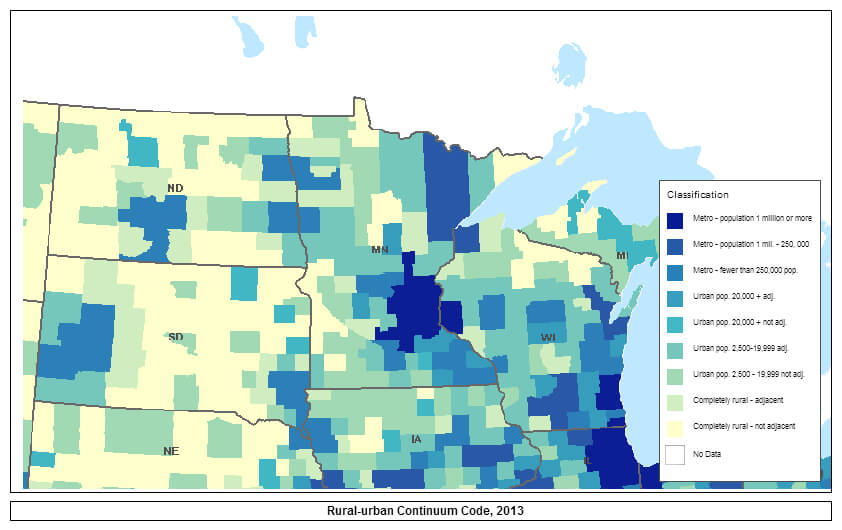 Image: Blog hero Plant Plate 09 boys dig in
Image: Blog hero Plant Plate 09 boys dig in
A Down-and-Dirty Rural Definition
by Blandin Foundation Posted in Vibrant Rural
Here are the words you don’t want to hear at the beginning of rural policy meetings:
“Before we get into our topic, let’s take a quick look at how we are going to define rural.”
There’s never anything quick about it. Hours later, after the last statistician, artist, organizer, or demographer has collapsed in fatigue, you might be ready to move on to your real topic.
[pullquote]Yet, for all the difficulties of definition, we know rural America exists, because we’ve experienced it.[/pullquote] Many of us live there (about a quarter of Minnesotans and a fifth of the nation, but that depends on how you define it). And almost all of us care about the health and future of our rural communities, whether we live in a big city or the countryside.
The first thing to acknowledge is that defining rural depends on the policy context. Are you dealing with waste water, communications, transportation, education, culture, regional planning? Each policy area might require a slightly different approach to the definition.
Are you engaged in a five-year scholarly study or a 30-minute down-and-dirty analysis for a member of the press who needs the answer yesterday?
Are you looking within just one state, a region, nationally?
Are you expected anywhere for supper?
The way you answer any of these questions can help you decide which definition to use.

At the Daily Yonder, our fallback definition is the federal Office of Management and Budget metro classification system. It’s by far the easiest definition. It’s also probably the most imprecise (but we’ll get to that later).
OMB designates something called metropolitan statistical areas, or MSAs. The MSA definition is binary; counties are either in an MSA or they are not. If you’re in an MSA, you’re metro. If you aren’t in an MSA, you’re nonmetro, and by convention, rural. (OK, it’s not quite that simple, but we’ll get to that later, too.)
So how do you define an MSA? It’s any county that has a city of 50,000 residents or more. Plus it’s also the adjacent counties that have a large percentage of residents who commute to the core county for work.
Hennepin County, for example, is in an MSA because it has a city with a population of more than 50,000. (Minneapolis has about 400,000 residents). Mille Lacs County is also in the Minneapolis-St. Paul metro area because of its measurable economic connection to Minneapolis and St. Paul. But Mille Lacs has many characteristics we would think of as rural. The largest city is Princeton, with only about 5,000 residents. It’s a good 50 or so miles from the urban center of Minneapolis and St. Paul. It is less densely populated, has lots of towns under 1,000 residents, and contains part of the Mille Lacs Band of Ojibwe reservation. And yet it’s metro.
As with any binary system (off/on, day/night, big/little), the stark choice between metro and nonmetro means it glosses over the many subtle (and no-so-subtle) variations in the spectrum between urban and rural. It treats Minneapolis the same as Milaca (the county seat of Mille Lacs County, population 2,900). And it treats nonmetro locations as diverse as Brown County (population 26,000) and Lake of the Woods County (population 4,000) the same.
Demographers get around part of this problem by breaking nonmetro counties into two categories – micropolitan (counties that have small cities – from 10,000 to fewer than 50,000 residents) and noncore (counties outside an MSA that don’t have any cities of 10,000 and up).
In Minnesota, 17 counties and 656,000 residents are micropolitan, and 43 counties (with 585,000 residents) are noncore. The remaining 27 counties with about 4 million residents (or about three quarters of the population) are metro by these definitions.
If you want to dig deeper into what is rural, the USDA uses “continuum codes,” which do a better job of differentiating some of the more subtle shades between urban and rural. (If you want to see how these different classifications look for Minnesota or another state, visit the Economic Research Services Rural Atlas and fool around with the “county classification” tables.)
And there’s a Census definition that gets well below the county level. For some public policy discussions, the Census tract definition is a better tool, especially when you are talking about services like broadband, where there can be big differences between the experiences of residents of sparsely populated areas and residents of even very small towns.
But for many public policy discussions, going beyond the county level may not be practical. State and federal government don’t track much real-time economic data by Census tract, so it’s not effective for things like ongoing economic analysis (unemployment reports, for example). And we don’t design many government services around Census tracts, so it’s less useful for policy discussions.
So, there you have it: One quick and flawed way to define “rural.” It’s a simple and imprecise tool for examining the way rural economies, cultures and environments work. Use it with care. And save some energy for the topics you really want to discuss, like how to build stronger and more resilient rural communities.
Tim Marema is editor of the Daily Yonder, a rural news site published by the Center for Rural Strategies.
———————————————————————————————————————————————————————-
What definition of rural does your organization use? Post below!
For other resources discussing the definition of rural, see below.
http://www.rupri.org/Forms/RuralDefinitionsBrief.pdf
http://www.raconline.org/topics/what-is-rural
http://ric.nal.usda.gov/what-is-rural
Sign Up for E-News
Subscribe to our periodic newsletter for updates and opportunities about vibrant rural Minnesota.